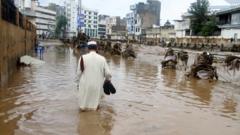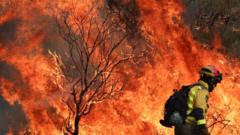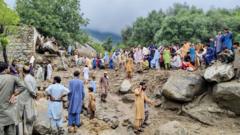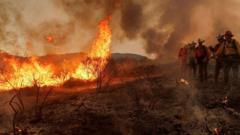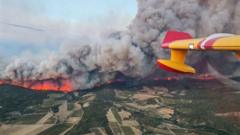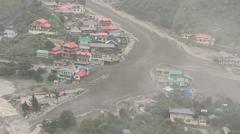The recent monsoon flooding in Pakistan has claimed hundreds of lives and left more than 200 missing as rescue operations struggle amidst the destruction. Climate change is exacerbating these extreme weather events.
Pakistan's Devastating Floods: Over 200 Still Missing Amidst Climbing Death Toll
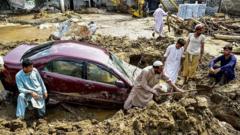
Pakistan's Devastating Floods: Over 200 Still Missing Amidst Climbing Death Toll
Devastating floods and landslides in Pakistan have resulted in over 300 fatalities, with more than 200 individuals still unaccounted for in the worst-hit Buner district.
In a tragic development following recent monsoon floods, officials in north-west Pakistan report that more than 200 individuals are still missing in the Buner district, one of the areas most severely impacted. The official death toll has now surpassed 300, with fatalities reported across Pakistan and Pakistan-administered Kashmir, particularly in the mountainous Khyber Pakhtunkhwa province, where the disaster has been most pronounced.
Jehangir Khan, a spokesperson for the deputy commissioner's office in Buner, informed the BBC that at least 209 people remain unaccounted for, a figure expected to rise as rescue efforts continue. He noted that rescue teams have already buried eight unnamed bodies due to the absence of family members to claim them, attributing this to significant road damage hindering access.
Provincial disaster management authority head Asfandyar Khattak confirmed that “dozens” of people are also missing in the neighboring Shangla district, while reports indicated that up to 12 complete villages have been partially buried under debris.
This disaster comes amid the backdrop of South Asia’s annual monsoon season, which typically spans from June to September and delivers a majority of the region's yearly rainfall. However, climate change is reportedly intensifying these weather patterns, leading to more frequent and severe landslides and floods. Torrential downpours have also been recorded in Indian-administered Kashmir following similar devastating flash floods that killed at least 60 individuals recently.
In Pakistan-administered Kashmir, authorities confirmed that nine fatalities occurred this week alone, with an additional five lives lost in the northern Gilgit-Baltistan region. Forecasts predict continuous heavy rainfall will persist until August 21 in these areas, which have been declared disaster zones.
As of this year, Pakistan has grappled with the consequences of an increasingly severe monsoon season since June, reporting approximately 650 deaths thus far. Recent data reveals that Punjab, which houses nearly half of Pakistan's population, experienced 73% more rainfall last July compared to the previous year, resulting in more fatalities than recorded throughout the last monsoon season.
The northern part of Pakistan, known for its towering glaciers, faces rapid glacial retreat exacerbated by climate change. These changes contribute to landslides as the surrounding rock and soil becomes increasingly unstable. While investigations continue regarding the precise origins of the recent floods, glaciologists underscore that melting ice is a significant contributing factor to the ongoing crisis.

